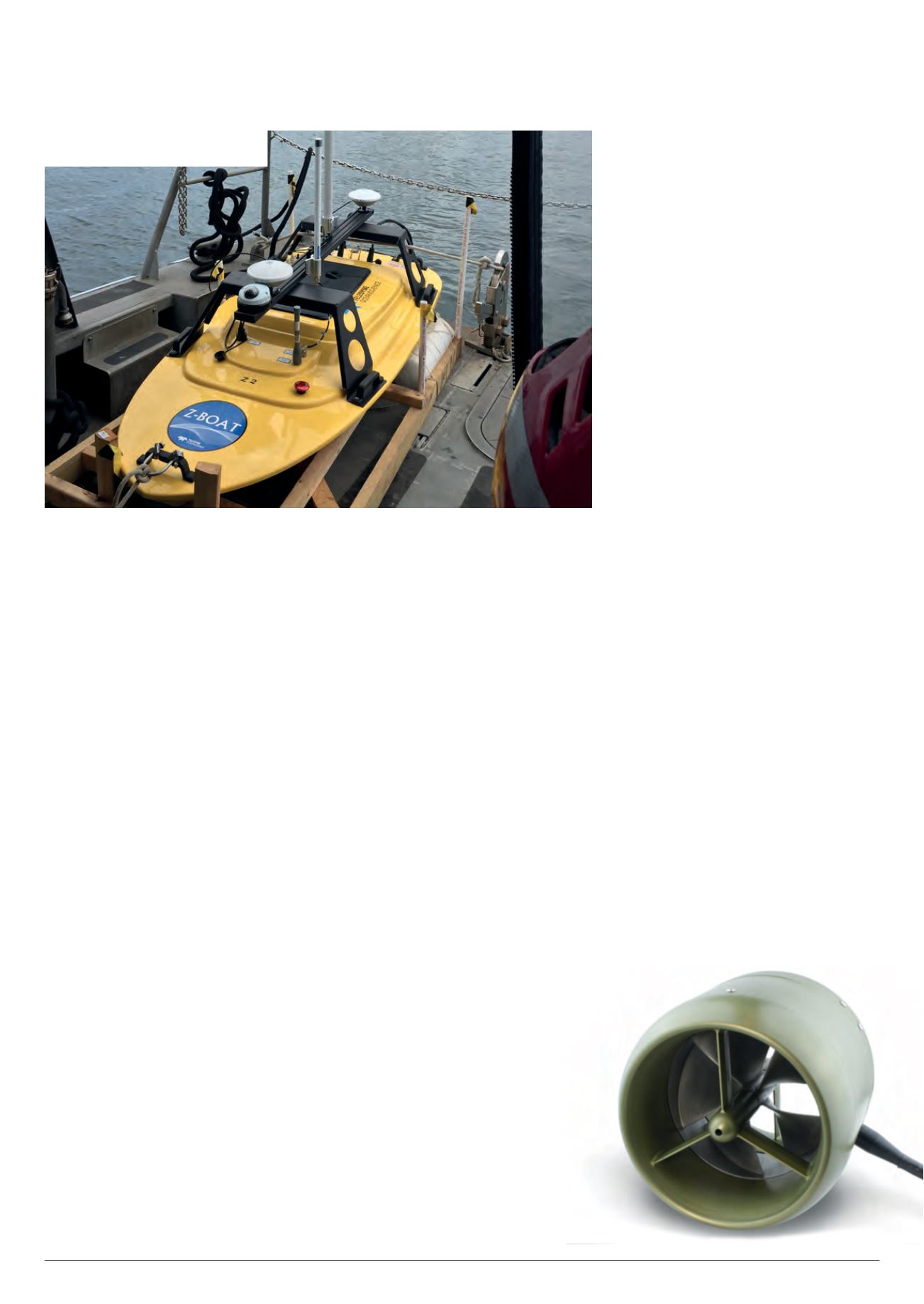

88
Show report
|
Oceanology International 2016
customisation of platforms without requiring
a gel coating or hand work on the finish.
Also, wear and tear is not as noticeable
when compared with a gel-coated
glass-reinforced plastic, as the colour
is integral to the material. ABS can also
allow for a stronger adhesive bond, aiding
manufacturability and customisation.
Navigation and telemetry systems are
provided by Hitec, with 2.4 GHz FHSS and
a 1200 m range for the remote navigation
system. Data telemetry operates up to
2 km away on 5 GHz MIMO, or 4G LTE
may be used for worldwide coverage.
The craft can use 30-40 Ah lithium-
ion or NiMH batteries with a maximum
endurance of 4.5 hours, and standard
operating speed is about 3-3.5 knots with
8 knots as top speed, powered by dual
brushless 24 V dc outdrives.
iXBlue launched its new INS for
ROV pilots performing maintenance and
construction tasks.
Designed for ROV navigation with
integration of either iXBlue or third-
party sensors, the Rovins Nano claims
greater positioning accuracy compared
with DVLs owing to its integrated inertial
navigation system algorithm, capable of
collecting acoustic data regardless of
depth. Position accuracy can be further
enhanced through navigation with a
DVL, or by station-keeping with DVL or
acoustic systems.
“In the future it will no longer be
necessary to use a DVL. Even in
‘sparse array’ long baseline fields, the
combination of the Rovins Nano system
and iXBlue Ramses acoustic synthetic
baseline positioning system enables
extremely accurate positioning data,” said
Paul Wysocki.
The 10 kg cylindrical device (6 kg in
water) interfaces with the control system
over a 100 Mbit Ethernet connection or
an RS-232/422 serial interface at up to
200 Hz. It can operate from -20 to +55 C
and is resistant to shocks, vibrations and
harsh environments with high pressures,
low temperatures or pollution.
Dynamic heading recordings are
accurate to 0.5
º
, and to 0.1
º
on the roll
and pitch of the vehicle. Communications
and up to 24 V of power (dc) are
supplied through three 12-pin Seacon
Mini-Con connectors and one 26-pin
Micro Mini-Con connector located atop
the titanium housing.
TSL Technology has developed a
1 kW bidirectional thruster, the latest
addition to its range of submersible
propulsors for AUVs, small and work-class
ROVs, and manned underwater systems.
The new 150 mm marine-grade
aluminium system provides 105 N of
symmetric thrust at 300 W (or 237 N
at 1 kW) forwards or in reverse, having
been engineered from the ground up
and optimised using advanced CFD
techniques. “Robust, automated and
extensively validated RANS codes
enabled the co-optimisation of motor,
duct and propeller performance,” added
TSL’s Aleksander J Dubas.
An electric rim drive has been
integrated into the housing of the thruster,
resulting in a compact low-maintenance
design with a single rotating part,
using no gearbox, coupling or space-
consuming inline motor. Externally, the
thruster is 208 mm in diameter and
200 mm in length, and the system
weighs 7.7 kg above water and 4.5 kg in
fresh water.
The system also uses sensorless
controllers, eliminating the need for Hall
effect sensors (or other shaft position
sensors) and requiring only a single
60 V dc power supply cable.
Atlantas Marine showcased a
new
offering aimed at making cathodic
protection (CP) surveys quicker and
easier. The CP video overlay unit consists
of a small black box that can be quickly
interfaced with the cathodic measurement
probe and video display of any ROV.
When an ROV is driven against a hull or
June/July 2016 |
Unmanned Systems Technology
TSL’s new thruster provides
105 N of thrust at 300 W
Teledyne’s Z-Boat has a modular deck
for mounting cameras and antennae









